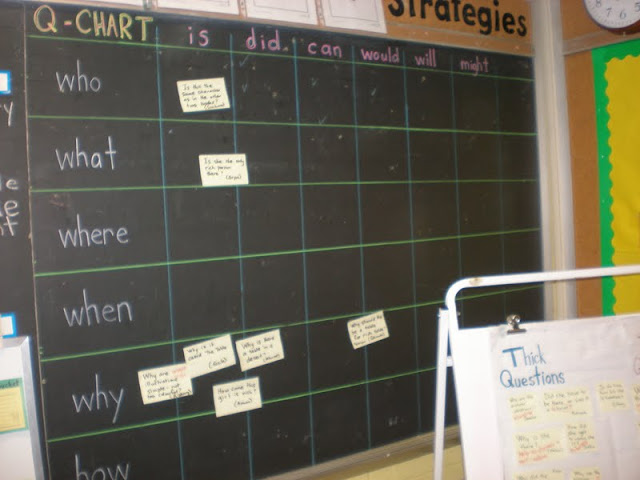Micheline has worked very hard to integrate the strategy of questioning into every facet of her classroom. Moving beyond using it simply as a reading comprehension strategy, she anchors many of her lessons around what her students wonder. This leads to rich contexts to share their thinking and research aspects of a topic that is important to them and self-direct their learning. During her Reading Workshop, Micheline uses a three-part lesson format to organize her time and address the needs of her students in small groups, as well as in learning centres.
Part I: Mini-lesson
Micheline refers to some work the class has done in a previous lesson, looking at thick vs. thin questions. She then moves into another text and asks students to think about any questions they have while she reads. As she reads, she stops periodically to have students think/pair/share their ideas and share their questions with the larger group. Micheline then writes these questions on sticky notes and adds them to their class Q-Chart.






Part II: Independent/Guided Practice
In order to meet students in small groups for guided reading, Micheline uses learning centres for students to work at independently. She spent a lot of time setting up the routines and expectations of these centres with her students at the beginning of the year. She doesn't always use the centres as sometimes she has her students doing independent reading during this time. Students work on their task quietly and are able to work with another member of their group, if needed.




The "I Wonder" table is an integral part of her centres. This table integrates the different Science or Social Studies topics into her Language program as she carefully chooses items connected to the big ideas of those units. In addition to this cross-curricular integration, Micheline also pays close attention to the interests of her students when changing the items in this centre. If there is something they are interested in, or talking about, she includes it here so they can investigate further and think about the topic.

While the rest of the class is working at the centres or reading independently, Micheline works with a small group, addressing common needs in their reading. Using different leveled texts, and integrating the mini-lesson focus, she guides students in their thinking and progression as readers.





Part III: Group Share and Consolidation
To end her Reading Workshop, Micheline brings her students back together to have them share what they did and what they learned. This is not only an accountability piece for her class, but it also consolidates the learning for the period. Here, students share their questions from the "I Wonder" table and together, the class looks for possible answers. Micheline models how to look for information and that research doesn't always have to result in going through the research process or writing a report.

Here are a couple of Q-Charts, the second one divided into categories of questions, instead of levels:
No comments:
Post a Comment